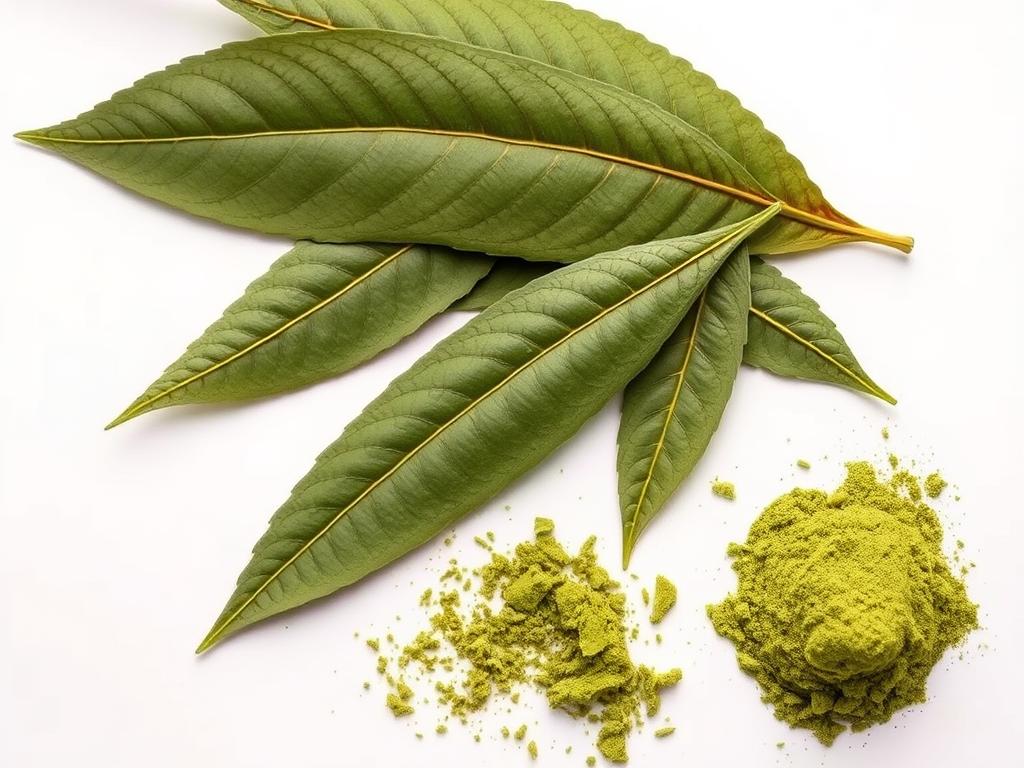
Understanding Kratom: Nature’s Pain Relief Option
Kratom (Mitragyna speciosa) is a tropical tree native to Southeast Asia, where it has been used for centuries as a traditional medicine. The leaves of this coffee family plant contain compounds that interact with opioid receptors in the brain, producing effects that range from stimulation at low doses to sedation and pain relief at higher doses.
Unlike pharmaceutical medications, kratom is typically consumed as a powder made from dried leaves, which can be taken as a tea, mixed with food, or encapsulated. The active compounds in kratom, primarily mitragynine and 7-hydroxymitragynine, are responsible for its effects on the body.
In Southeast Asia, kratom has a long history of use by agricultural workers to boost energy and productivity during long workdays. More recently, it has gained popularity in Western countries as people seek alternatives to prescription pain medications.
Pharmaceutical Pain Medications: The Standard Approach

Pharmaceutical opioids like hydrocodone (Vicodin) and oxycodone (OxyContin, Percocet) are synthetic or semi-synthetic compounds designed to mimic the effects of natural opiates. These medications are FDA-approved and prescribed by healthcare providers for moderate to severe pain.
These medications work by binding to opioid receptors throughout the body, blocking pain signals and producing feelings of euphoria. Their effectiveness for short-term pain management is well-established through clinical trials and decades of medical use.
However, pharmaceutical opioids come with significant concerns. The CDC reports that over 70,000 Americans died from drug overdoses in 2019, with prescription opioids involved in many of these deaths. The risk of physical dependence, addiction, and respiratory depression (the primary cause of fatal overdoses) has led to stricter prescribing guidelines and a search for alternatives.
How They Work: Mechanism of Action Comparison
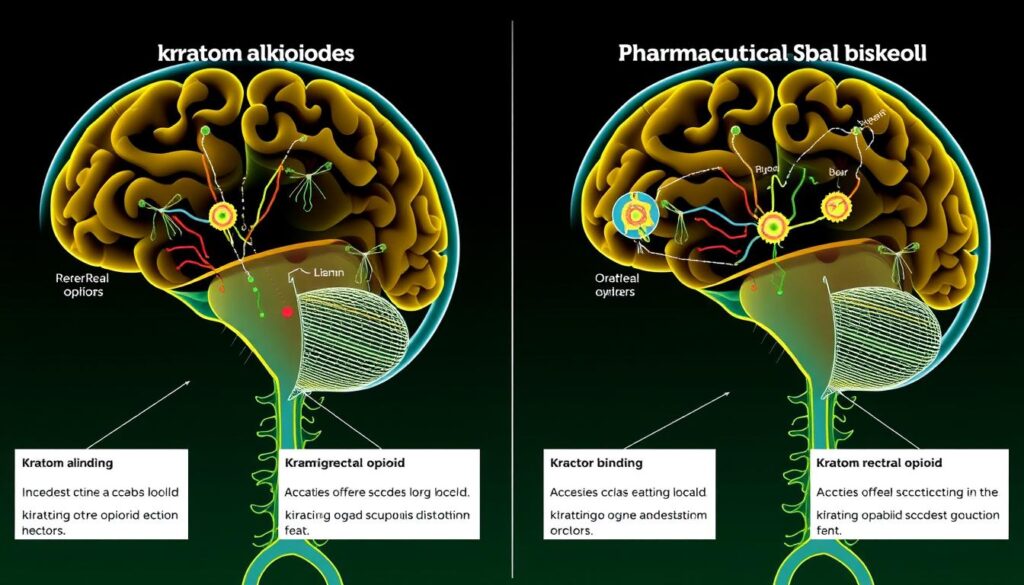
Pharmaceutical Opioids: Full Agonist Activity
Pharmaceutical opioids like hydrocodone and oxycodone function as full agonists at mu-opioid receptors. This means they fully activate these receptors, producing strong pain relief but also triggering the respiratory depression pathway that can lead to dangerous side effects. These medications primarily work through the beta-arrestin pathway, which is associated with respiratory depression, constipation, and dependence.
Kratom: Partial Agonist with Biased Signaling
Kratom’s primary alkaloids work differently. Research indicates that mitragynine and 7-hydroxymitragynine act as partial agonists at mu-opioid receptors. This means they don’t fully activate these receptors, potentially resulting in a ceiling effect that limits both benefits and risks.
Importantly, kratom alkaloids demonstrate what scientists call “biased signaling.” They preferentially activate the G-protein coupled pathway while minimizing activation of the beta-arrestin pathway. This unique mechanism may explain why kratom appears to cause less respiratory depression than classical opioids.
Additionally, kratom contains compounds that interact with other receptor systems, including adrenergic receptors, which may contribute to its stimulant effects at lower doses and potentially provide pain relief through non-opioid mechanisms.
Pain Relief Effectiveness: How Do They Compare?
Pharmaceutical Pain Medications: Clinical Evidence
Pharmaceutical opioids have extensive clinical research supporting their effectiveness for acute pain. Multiple randomized controlled trials demonstrate their ability to significantly reduce pain intensity across various conditions. For short-term use, such as post-surgical pain or injury, these medications provide reliable and potent relief.
However, their effectiveness for chronic pain is more controversial. Long-term studies show diminishing returns as tolerance develops, often requiring increasing doses to maintain the same level of pain relief. This pattern can lead to dependence and increased risk of side effects.
Kratom: Emerging Evidence
The evidence for kratom’s effectiveness comes primarily from observational studies, surveys, and traditional use rather than controlled clinical trials. A 2020 survey by Garcia-Romeu and colleagues found that among 2,798 kratom users, 91% reported using it for pain, with 87% reporting effective relief.
In the only published randomized controlled trial examining kratom’s analgesic effects, researchers found that kratom significantly increased pain tolerance compared to placebo in a laboratory pain test. However, this was a small study with 26 participants.
Anecdotal reports suggest kratom may be particularly useful for chronic pain conditions, including back pain, arthritis, and fibromyalgia. Many users report that kratom provides adequate pain relief with fewer side effects than prescription medications.
Side Effects and Safety Profiles
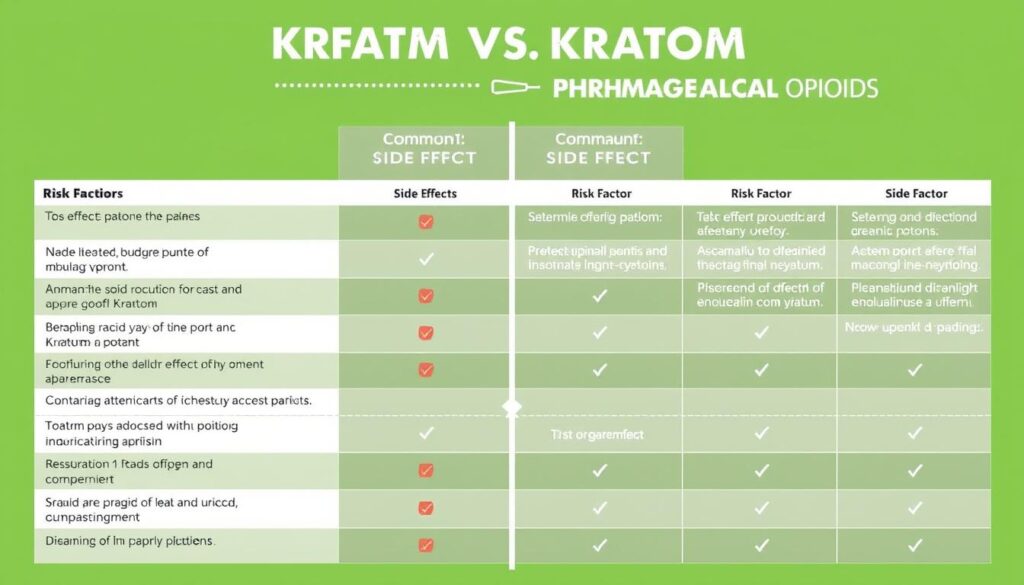
Pharmaceutical Opioids: Known Risks
- Respiratory depression (potentially fatal)
- High physical dependence potential
- Severe withdrawal symptoms
- Constipation and gastrointestinal issues
- Sedation and cognitive impairment
- Risk of overdose, especially when combined with other substances
- Well-documented side effect profile
- Standardized dosing and purity
Kratom: Emerging Safety Profile
- Nausea and gastrointestinal discomfort
- Moderate dependence potential
- Milder withdrawal symptoms
- Inconsistent potency between products
- Potential for contamination in unregulated products
- Limited long-term safety data
- Possible liver effects in some individuals
- Stimulant effects at low doses (may be beneficial or unwanted)
Respiratory Depression: A Critical Difference
Perhaps the most significant safety difference between kratom and pharmaceutical opioids involves respiratory depression. Classical opioids can suppress breathing, especially at higher doses or when combined with other substances like alcohol or benzodiazepines. This respiratory depression is the primary mechanism behind fatal opioid overdoses.
Laboratory research suggests kratom’s alkaloids may cause significantly less respiratory depression due to their biased signaling at opioid receptors. While this doesn’t mean kratom is risk-free, it may explain why fatal overdoses attributed solely to kratom are exceedingly rare compared to pharmaceutical opioids.
Important Safety Note: The FDA has not approved kratom for any medical use and has expressed concerns about its safety. Reports of adverse events, while relatively rare compared to the estimated number of users, include seizures, liver problems, and deaths (though most fatalities involved multiple substances). Always consult a healthcare provider before using any substance for pain management.
Addiction Potential and Withdrawal

Pharmaceutical Opioids: High Dependence Risk
Pharmaceutical opioids carry a well-documented risk of dependence and addiction. Physical dependence can develop within days of regular use, with tolerance requiring increasing doses to achieve the same effect. Withdrawal symptoms can be severe, including intense cravings, muscle aches, insomnia, diarrhea, vomiting, and psychological distress.
The addictive potential of these medications is reflected in the opioid crisis, with an estimated 1.6 million Americans suffering from opioid use disorder related to prescription opioids. Even when taken as prescribed, physical dependence is a common outcome of regular use.
Kratom: Lower But Real Dependence Risk
Research suggests kratom has a lower potential for dependence than classical opioids, but dependence can still occur with regular use, particularly at higher doses. Animal studies indicate that mitragynine (kratom’s primary alkaloid) does not produce the same reinforcing effects as morphine, suggesting lower abuse potential.
Withdrawal from kratom is typically described as milder than opioid withdrawal, with symptoms including muscle aches, insomnia, irritability, nausea, and mood disturbances. These symptoms generally resolve within a few days to a week, compared to the more protracted withdrawal from pharmaceutical opioids.
Interestingly, some individuals report using kratom specifically to manage opioid withdrawal symptoms or as a replacement for more harmful opioids. A 2019 survey by Coe and colleagues found that 41% of kratom users reported using it to reduce or stop opioid use, with 90% reporting it effective for this purpose.
Legal Status and Accessibility

Pharmaceutical Opioids: Strictly Regulated
Pharmaceutical opioids are classified as Schedule II controlled substances under federal law, indicating their high potential for abuse. They require a prescription from a licensed healthcare provider and are subject to strict regulations regarding refills and quantity limits.
These regulations have tightened in recent years in response to the opioid crisis, making it more difficult for patients to obtain these medications even when medically necessary. This has created challenges for individuals with legitimate pain needs.
Kratom: Variable Legal Status
Kratom exists in a legal gray area in the United States. At the federal level, it remains legal but is not approved by the FDA for any medical use. The DEA considered classifying kratom as a Schedule I controlled substance in 2016 but withdrew this proposal following public outcry and calls for more research.
At the state level, kratom’s legal status varies. As of 2023, kratom is banned in six states (Alabama, Arkansas, Indiana, Rhode Island, Vermont, and Wisconsin) and somernaturally, such as Thailand, legal status has shifted. Thailand, which had banned kratom despite its traditional use, recently decriminalized and is now promoting it as an economic crop.
| Aspect | Pharmaceutical Opioids | Kratom |
| Federal Legal Status | Schedule II Controlled Substance | Legal but not FDA-approved |
| Prescription Required | Yes | No |
| Purchase Locations | Licensed pharmacies only | Specialty shops, online vendors |
| Quality Control | FDA-regulated manufacturing | Varies widely, some voluntary standards |
| Drug Testing | Detected in standard tests | Not detected in standard tests |
Cost Comparison
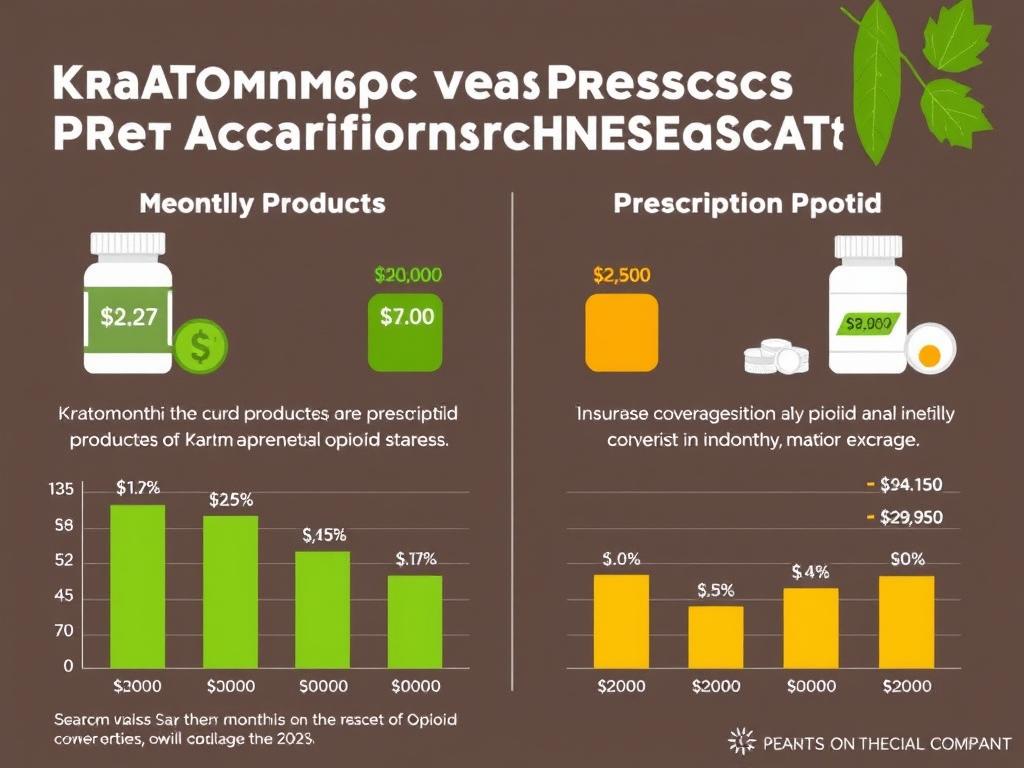
Pharmaceutical Opioids: High Costs, Insurance Coverage
The cost of pharmaceutical opioids varies widely depending on insurance coverage, generic availability, and dosage. Without insurance, a month’s supply of hydrocodone/acetaminophen can cost $25-$100, while brand-name extended-release oxycodone can exceed $300 per month.
These medications are typically covered by insurance, though with varying copays and restrictions. However, the total cost of pharmaceutical pain management often includes additional expenses like doctor visits, drug testing, and treating side effects.
Kratom: Out-of-Pocket but Lower Cost
Kratom is not covered by insurance since it’s not an FDA-approved medication. Users buy kratom online directly from vendors, with prices typically ranging from $30-$200 per month depending on quality, quantity, and form (powder vs. capsules).
While the direct cost may be lower than some pharmaceuticals, the lack of insurance coverage means all expenses are out-of-pocket. Additionally, the unregulated nature of the market means quality can vary significantly between products and vendors.
Financial Considerations
When evaluating the cost of pain management options, consider:
- Direct medication costs
- Insurance coverage and copays
- Healthcare provider visits
- Potential costs of side effect management
- Work productivity impacts
Medical Supervision and Prescription Requirements

Pharmaceutical Opioids: Structured Medical Oversight
Pharmaceutical opioids require a prescription from a licensed healthcare provider, ensuring medical supervision throughout treatment. This typically involves:
- Initial evaluation and diagnosis
- Regular follow-up appointments to assess effectiveness and side effects
- Monitoring for signs of dependence or misuse
- Urine drug screening in many cases
- Structured tapering when discontinuing
This medical oversight provides safety guardrails but can also create barriers to access, especially for patients in rural areas or those without adequate insurance coverage.
Kratom: Self-Directed Use
As an unregulated herbal product, kratom use is typically self-directed without formal medical supervision. Users determine their own dosing, frequency, and duration of use based on personal experience and information gathered from various sources.
This autonomy can be empowering for some but presents risks, including:
- Lack of professional guidance on appropriate use
- Potential for interactions with medications or health conditions
- Variable product quality and potency
- Delayed medical care for serious conditions
Important: Healthcare providers should be informed about all substances used for pain management, including kratom. While many doctors may be unfamiliar with kratom, open communication is essential for safe and effective care.
User Experiences and Anecdotal Evidence

Pharmaceutical Opioids: Mixed Experiences
User experiences with pharmaceutical opioids vary widely. Many report effective pain relief, especially for acute conditions, but others describe a complex relationship with these medications:
“The hydrocodone worked well for my pain after surgery, but I felt foggy and disconnected. When I tried to stop taking it after two weeks, I experienced withdrawal symptoms I wasn’t prepared for.”
Common themes in user reports include initial effective relief followed by tolerance, concerns about dependence, and side effects like constipation and cognitive impairment. Many also report difficulties with access due to increasing regulations.
Kratom: Diverse Applications
Kratom users report a range of experiences, with many describing it as a life-changing alternative:
“After years of taking prescribed opioids for my chronic back pain, I was concerned about long-term use. Kratom has allowed me to manage my pain with fewer side effects and a clearer mind. It’s not perfect, but it’s been a better option for me.”
Surveys of kratom users consistently show high satisfaction rates, with many reporting improved quality of life and functionality. Some specifically note using kratom to reduce or eliminate pharmaceutical opioid use.
However, not all experiences are positive. Some users report inadequate pain relief, unpleasant side effects, or difficulties managing use. The variability in product quality and potency is a common concern.
What do users say about transitioning from pharmaceuticals to kratom?
Many users report a transition period when switching from pharmaceutical opioids to kratom. Some describe initial withdrawal symptoms from the pharmaceutical followed by adjustment to kratom’s different effects. Most successful transitions involve a gradual tapering of the pharmaceutical while slowly introducing kratom, ideally under medical supervision. Users often report that kratom provides different quality of pain relief – sometimes described as less complete but with fewer side effects and greater functionality.
Current Research and Scientific Consensus

The State of Kratom Research
Research on kratom is still in its early stages compared to pharmaceutical opioids. Most studies have focused on kratom’s pharmacology and mechanism of action rather than clinical outcomes. Key findings include:
- Kratom’s primary alkaloids act as partial mu-opioid receptor agonists with biased signaling
- Animal studies suggest lower abuse potential than classical opioids
- Preliminary evidence indicates less respiratory depression than full opioid agonists
- Observational studies show widespread use for pain management with generally positive self-reported outcomes
However, significant research gaps remain, including:
- Few controlled clinical trials examining efficacy for specific pain conditions
- Limited long-term safety data
- Incomplete understanding of drug interactions
- Insufficient standardization of kratom products for research purposes
Scientific Consensus and Expert Opinions
There is no clear scientific consensus on kratom’s role in pain management. Expert opinions vary widely:
“Kratom contains compounds that interact with opioid receptors in the brain, which may expose users to the risks of opioid addiction, abuse, and dependence.”
“The available science suggests that kratom’s opioid properties are considerably more nuanced, and that mitragynine could offer therapeutic advantages… This highlights the importance of conducting well-controlled, mechanistic studies.”
Many researchers advocate for more studies rather than regulatory restrictions, arguing that kratom may represent an important opportunity to develop better pain management options with reduced harm potential.
Recommendations for Different Pain Management Scenarios
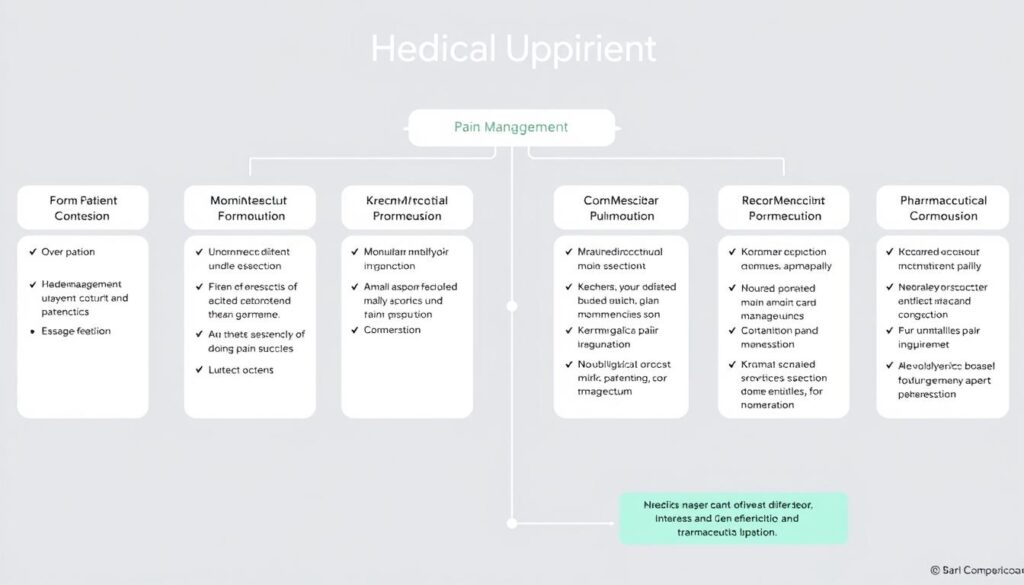
Pain management should always be individualized based on the specific condition, patient characteristics, and treatment goals. While we cannot provide medical advice, here are general considerations for different scenarios:
Acute Severe Pain (Post-surgical, Injury)
Pharmaceutical Opioids: May be appropriate for short-term use under close medical supervision. Their proven efficacy and standardized dosing make them suitable for predictable, time-limited pain.
Kratom: Limited evidence for severe acute pain. Variability in potency and onset makes it less predictable for severe pain management.
Chronic Pain Conditions
Pharmaceutical Opioids: Generally not recommended as first-line treatment for most chronic pain conditions due to limited evidence of long-term benefit and significant risks. May be appropriate for some patients after careful risk assessment and when other options have failed.
Kratom: Some patients report success managing chronic pain with fewer side effects than pharmaceuticals. May be worth discussing with a knowledgeable healthcare provider, particularly for patients who have had negative experiences with pharmaceutical options.
Transitioning from Opioid Medications
Medically Supervised Approach: Tapering pharmaceutical opioids under medical supervision, potentially with FDA-approved medications for opioid use disorder like buprenorphine, is the safest approach.
Kratom Considerations: Some individuals report successfully using kratom to ease opioid withdrawal and transition away from pharmaceuticals. This approach carries risks and should ideally involve medical oversight.
Comprehensive Approach to Pain Management
Regardless of which pain management approach is chosen, a comprehensive strategy typically yields better results than relying solely on any single treatment. Consider incorporating:
- Physical therapy and appropriate exercise
- Psychological approaches (cognitive behavioral therapy, mindfulness)
- Non-opioid medications (NSAIDs, anticonvulsants, etc.)
- Interventional procedures when appropriate
- Lifestyle modifications (sleep hygiene, stress management)
Ready to Explore Comprehensive Pain Management?
Speak with a healthcare provider who specializes in pain management to develop a personalized approach that addresses your specific needs and concerns.
Conclusion: Making Informed Decisions About Pain Management

The comparison between kratom and pharmaceutical pain medications reveals a complex landscape with no one-size-fits-all solution. Pharmaceutical opioids offer standardized, well-studied pain relief but come with significant risks of dependence, side effects, and potential for misuse. Kratom presents an alternative with a different mechanism of action and potentially lower risk profile, but lacks the rigorous clinical testing and standardization of pharmaceuticals.
As research continues to evolve, the most important considerations for anyone managing pain include:
- Open communication with healthcare providers about all pain management approaches
- Recognition that effective pain management often requires multiple strategies
- Careful weighing of benefits and risks based on individual circumstances
- Awareness of the limitations in current knowledge, particularly regarding kratom
- Focus on functional improvement and quality of life, not just pain reduction
Whether considering pharmaceutical medications, kratom, or other approaches, the goal should be informed decision-making that prioritizes both safety and effective pain relief. For many, this may involve a combination of approaches tailored to their specific needs and regularly reassessed as circumstances change.
Take Control of Your Pain Management Journey
Learn more about comprehensive approaches to pain management and connect with specialists who can help you navigate all available options.



